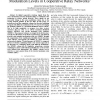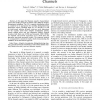VTC
2008
IEEE
14 years 6 months ago
2008
IEEE
Abstract— In this contribution, we investigate the attainable performance of quasi-cyclic (QC) protograph Low-Density Parity-Check (LDPC) codes for transmission over both Additiv...
VTC
2008
IEEE
14 years 6 months ago
2008
IEEE
In digital cooperative relaying, signals from the source-destination and relay-destination links are combined at the destination to achieve spatial diversity. These signals do not ...
VTC
2008
IEEE
14 years 6 months ago
2008
IEEE
—Opportunistic beamforming (OB) relies on the transmission of Channel State Information (CSI) in the form of instantaneous Signal to Noise Ratio (SNR) from Mobile Stations (MSs) ...
VTC
2008
IEEE
14 years 6 months ago
2008
IEEE
Abstract—In this paper the Shannon capacity of generalizedgamma (GG) fading channels is studied, under different adaptive transmission techniques. The GG is a generic distributio...
VTC
2008
IEEE
14 years 6 months ago
2008
IEEE
—The adoption of wireless vehicular communication technologies would strongly depend on the technologies transmission reliability, required by QoS demanding traffic safety applic...
VTC
2008
IEEE
14 years 6 months ago
2008
IEEE
Abstract— Though cooperative communication has been intensively examined for general wireless systems, such as mobile and ad-hoc networks, it has been almost unexplored in the ca...
VTC
2008
IEEE
14 years 6 months ago
2008
IEEE
Abstract—In multiple-input multiple-output (MIMO) broadcast channels, multiuser diversity is exploited by scheduling data transmission to users with best channel conditions. To �...
VTC
2008
IEEE
14 years 6 months ago
2008
IEEE
—The EU WINNER projects have studied OFDM-based packet data systems beyond 3G that use adaptivity on all timescales to obtain high flexibility and performance. The adaptive trans...
VTC
2008
IEEE
14 years 6 months ago
2008
IEEE
—The accuracy of Time of Arrival (TOA) measurements is significantly compromised due to the multipath components which coexist with the desired Line of Sight (LOS) components in ...
VTC
2008
IEEE
14 years 6 months ago
2008
IEEE
— New GNSS signals are usually characterized by the presence of secondary codes and high data rates that can make the sign of the transmitted signal change each primary code peri...


